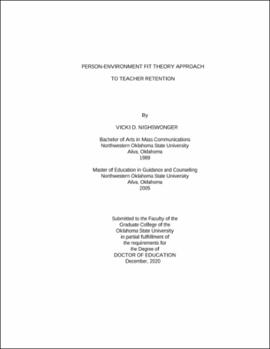| dc.contributor.advisor | Mania-Singer, Jackie | |
| dc.contributor.author | Nighswonger, Vicki D. | |
| dc.date.accessioned | 2021-05-25T20:32:10Z | |
| dc.date.available | 2021-05-25T20:32:10Z | |
| dc.date.issued | 2020-12 | |
| dc.identifier.uri | https://hdl.handle.net/11244/329924 | |
| dc.description.abstract | Recent research suggests the United States is experiencing a nation-wide teaching shortage. Though the shortage appears to differ from state to state, patterns of shortages appear most often in urban, high-poverty, and high-minority districts across the nation and in specific subject areas including math, science, and special education. On average, 8% of teachers leave the profession every year (Sutcher, Darling-Hammond, and Carver-Thomas, 2016) and another undocumented percentage leave schools or buildings for other teaching positions. Beyond the immediate needs, trends indicate the shortage is likely to worsen. Enrollment in teacher preparation programs has decreased 35% between 2009 and 2014 (Sutcher et al., 2016) and the number of alternative or uncertified teachers in the classrooms of some states has significantly increased (Associated Press, 2017). | |
| dc.description.abstract | Teachers often enter the profession with a passion for fostering student learning and the intent of maintaining a career in the field of education (Day & Gu, 2009; Farkas, Johnson, & Foleno, 2000). Despite their initial plans of a long teaching career, a disturbing number of individuals are leaving the profession or moving to another building. Olsen and Anderson (2007) believe that teacher satisfaction can be predicted through the "concept of 'fit,' the idea that most of the teachers had been able to find schools that were compatible with both their professional preparation and their reasons for entry" (p. 24). If teachers feel connected to the staff and administration within a particular building, they are more likely to be content in the career. This could increase teacher retention and job satisfaction and help to explain why some schools experience low teacher turn over while others in the same district struggle to retain teachers. | |
| dc.description.abstract | The purpose of this case study is to gain a better understanding of school factors that lead to high teacher retention rates within a building in a large, urban district while other schools in the same district experience high teacher turnover. The focus is to describe, from the teachers' perspectives, what factors have influenced their choice to remain in the profession and, specifically, factors that have influenced them to stay in their current building. | |
| dc.format | application/pdf | |
| dc.language | en_US | |
| dc.rights | Copyright is held by the author who has granted the Oklahoma State University Library the non-exclusive right to share this material in its institutional repository. Contact Digital Library Services at lib-dls@okstate.edu or 405-744-9161 for the permission policy on the use, reproduction or distribution of this material. | |
| dc.title | Person-environment fit theory approach to teacher retention | |
| dc.contributor.committeeMember | Curry, Katherine | |
| dc.contributor.committeeMember | Harris, Edward | |
| dc.contributor.committeeMember | Vasinda, Sheri | |
| osu.filename | Nighswonger_okstate_0664D_16938.pdf | |
| osu.accesstype | Open Access | |
| dc.type.genre | Dissertation | |
| dc.type.material | Text | |
| dc.subject.keywords | teacher retention | |
| thesis.degree.discipline | School Administration | |
| thesis.degree.grantor | Oklahoma State University | |
